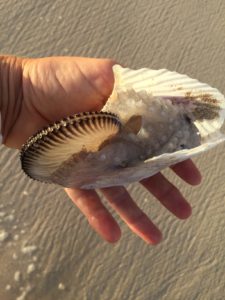
A female paper nautilus, or Argonaut octopus, found on Kailua Beach. All Argonauts with shells are females. Photo courtesy Jan Reichelderfur
December 1, 2020
One unexpected effect of the Covid crisis it that it’s getting me out walking more than usual, in different places, and for longer distances. This was also a bonus for Kailua resident Jan Reichelderfer, who emailed this note on Thanksgiving Day:
“I found a paper nautilus on Kailua Beach this morning. It was in the surf zone. After photographing it, I put it back beyond the shore break and it jetted off with a puff of ink! It seemed very healthy…”
Attached to the email were five photos (four shown here) of Jan’s gift from the sea.
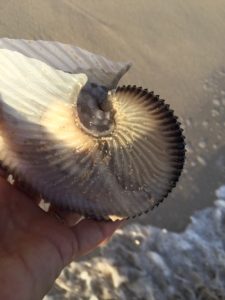
Photo courtesy Jan Reichelderfur
The two words, paper and nautilus, are far from adequate labels for this remarkable marine animal. The first name comes from their paper-thin shells, and the second, from their resemblance to a distant relative, the chambered nautilus. A paper nautilus, however, is an octopus.
The creatures’ scientific name, Argonaut, is a good one. In Greek mythology, Argo is the name of the ship Jason and the Argonauts sailed to find the Golden Fleece.
Four Argonaut species exist in the open oceans, including the Mediterranean. The largest, called the Greater Argonaut, has the scientific name Argonauta argo. The maximum-sized shell of this species (I don’t know which species is Jan’s) is about 12 inches long, the female inside 8 inches or so long. These pale, pink-spotted octopuses spend their lives drifting offshore just under the surface of tropical and subtropical oceans worldwide.
Aargo males are pipsqueaks at only an inch or so long. These little guys have the mind-boggling job of finding a mature female of the same species and fertilizing her eggs. Somehow, nature makes it work. Like other small octopuses, Argonauts live only about a year.
Bottom-dwelling female octopuses lay their eggs in cracks and crevices on the ocean floor, but with a lifestyle in the upper reaches of the open ocean, Argonauts don’t have that luxury. Instead, females evolved to build their own “nest” to hold their eggs.
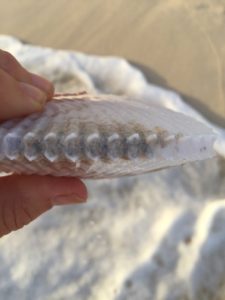
The outer edge of the female Argonaut’s shell. Photo courtesy Jan Reichelderfur
After mating, the mother Argonaut secretes a lovely calcite shell from the web space between her two uppermost arms. This easily-broken shell is different in composition from other mollusk shells, which consist of the sturdier calcium carbonate and a small amount of protein.
The female Argonaut lays up to 48,000 eggs inside her delicate chamber, and squeezes in there with them. By trapping an air bubble inside, the mother octopus drifts about without expending energy to keep from sinking. Her two front arms hang onto her brood shell, but she can shoot out her rear, sucker-lined arms to grab passing meals. Like all octopuses, Argonauts are carnivores, eating any other offshore animals they come across.
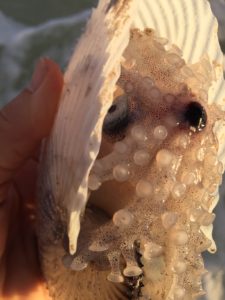
The octopus’s eye is peeking out of the shell on the left. The female’s mouth, called a beak, is the dark disk on the right. Photo courtesy Jan Reichelderfur
I have found two paper nautilus shells in my lifetime of beach walking, both on remote Mexico beaches in the Gulf of California. They are among my most treasured possessions.
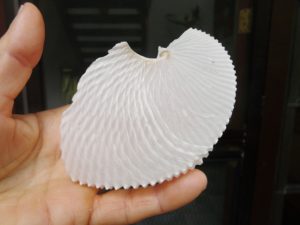
One of my Mexico Argonaut shells.
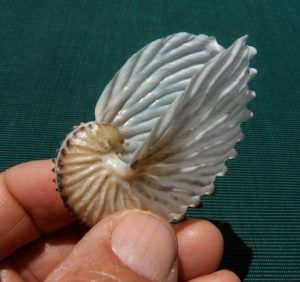
Another species of Argonaut shell from the Gulf of California, Mexico.
Jan’s Thanksgiving photos of her live paper nautilus are new Argonaut treasures that I’m happy, with her permission, to be able to share here. I’ve never seen a living Argonaut, but Jan’s experience has me walking Kailua and Lanikai Beaches even earlier and farther, especially when the tradewinds are blowing long and strong.
Strong onshore winds sometimes drive paper nautiluses ashore, but they’re rare finds here in Hawaii. Jan included in her email this uplifting thought: “With Covid we all need things to be thankful for and if it was a normal Thanksgiving morning, I would have been cleaning the house and not on an early morning beach walk.”
There are few silver linings in a pandemic, but finding a live Argonaut on an out-of-the- ordinary beach walk counts as a big one.
Argo means bright in Greek. Thank you, Jan, for brightening our day.